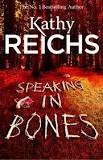Published by
Penguin Random House,
28 July 2016.
ISBN: 978-0-09-955809-5 (PB)
28 July 2016.
ISBN: 978-0-09-955809-5 (PB)
You’d think there was a limit to the number of variations on murder
mysteries based around old or well-weathered bones. Yet Kathy Reichs’s
bestselling series featuring forensic anthropologist Temperance Brennan now
runs to nineteen titles, and still she succeeds in pulling something a little
different out of the hat each time.
Speaking in Bones, the latest of Tempe’s adventures, has a lot in
common with the earlier titles: a mystery which requires a lot of unravelling;
interesting characters and a vivid sense of place; further developments in Tempe’s emotional rollercoaster of a personal
life; and the clipped, idiomatic style liberally laced with technical terms
which has become something of a trademark for Reichs.
The first of the interesting
characters is one of the factors which makes this title a little different from
the others. Hazel ‘Lucky’ Strike, self-styled websleuth, is present from the
outset, and her investigation is what fires up Tempe’s own sleuthing brain
cells. ‘Lucky’ is as eccentric as they come and determined to follow her
intuition through to the bitter end.
Websleuths, it appears, take
it upon themselves to follow up cold cases of murder, missing persons and other
crimes which the police have given up on, mainly by picking up leads online,
but also in the real world. Lucky has been pursuing a teenage girl whose family
insist has run off with a boyfriend, and enlists Tempe’s help when she unearths
a vital piece of evidence the police have missed, and becomes convinced the
girl’s bones are stashed in the county
medical examiner’s store.
Religious fanaticism soon
enters the picture, and the case becomes a great deal more complicated than it
appears. Tempe follows Lucky’s trail with the help, and sometimes hindrance, of
two contrasting cops, discovers more bones and a lot of conflicting
information, and eventually has a narrow escape as the denouement approaches.
Meanwhile, her personal life
is in chaos. The case is taking place in North Carolina, and her former lover
in Montreal is pressuring her to resume their relationship; her mother is in
love; her soldier daughter is in Afghanistan; and her accountant is chasing her
for information for her tax return.
The sum total is another
intriguing episode in the life of one of crime fiction’s most popular
protagonists. Kathy Reichs knows how to tell a good story and keep the reader
enthralled.
------
Reviewer: Lynne Patrick
Kathy Reichs was born July 7,
1948 She is a crime writer, forensic anthropologist and academic. She is vice president
of the American Academy of Forensic Scientists; a member of the RCMP National
Police Services Advisory Council; forensic anthropologist to the province of
Quebec; and a professor of forensic anthropology at the University of North
Carolina-Charlotte. Her first book, Déjà Dead , catapulted her to fame
when it became a New York Times bestseller, a Sunday Times bestseller
and won the 1997 Ellis award for best first novel. She is a producer of the
chilling hit TV series Bones. She has written eighteen bestsellers
featuring Dr Temperance Brennan, the most recent include Bones of the Lost
and Bones Never Lie. She has also written five bestsellers featuring
Tory Brennan: Virals, Seizure, Code, Exposure and Terminal.
Kathy is a forensic anthropologist
herself
kathyreichs.com
Lynne Patrick has been a writer ever since she could pick up a pen,
and has enjoyed success with short stories, reviews and feature journalism, but
never, alas, with a novel. She crossed to the dark side to become a publisher
for a few years, and is proud to have launched several careers which are now
burgeoning. She lives on the edge of rural Derbyshire in a house groaning with
books, about half of them crime fiction.











